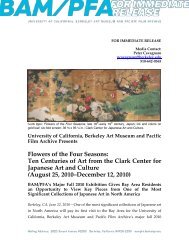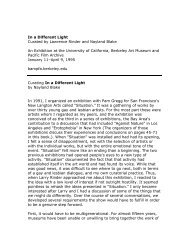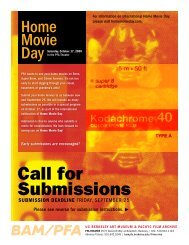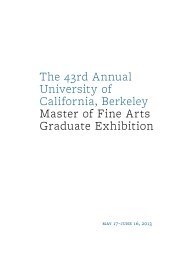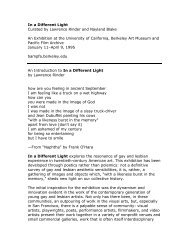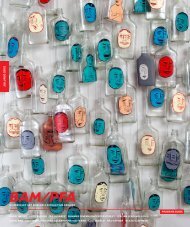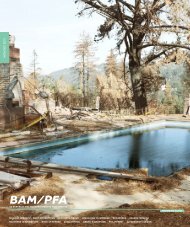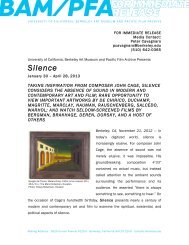Vincent Fecteau/MATRIX 199 - University of California, Berkeley
Vincent Fecteau/MATRIX 199 - University of California, Berkeley
Vincent Fecteau/MATRIX 199 - University of California, Berkeley
Create successful ePaper yourself
Turn your PDF publications into a flip-book with our unique Google optimized e-Paper software.
<strong>Vincent</strong> <strong>Fecteau</strong>/ M AT RIX 19 9<br />
“For some time I have been curious about<br />
the idea <strong>of</strong> affectation. I think it is related to<br />
my interest in models. Both are distancing<br />
mechanisms that create space around the<br />
‘real.’ I think it is this distance or space,<br />
full <strong>of</strong> complex and contradictory meaning,<br />
in which an ironic pose can express a<br />
sincere desire.”<br />
—<strong>Vincent</strong> <strong>Fecteau</strong> 1<br />
<strong>Vincent</strong> <strong>Fecteau</strong>/<strong>MATRIX</strong> <strong>199</strong><br />
Recent Sculpture<br />
August 11 – October 6, 2002<br />
<strong>University</strong> <strong>of</strong> <strong>California</strong><br />
<strong>Berkeley</strong> Ar t Museum<br />
December 4, 2002 – March 2, 2003<br />
Pasadena Museum<br />
<strong>of</strong> <strong>California</strong> Art<br />
When <strong>Vincent</strong> <strong>Fecteau</strong> begins one <strong>of</strong> his characteristic small-scale, meticulously handassembled<br />
three-dimensional objects, the possibilities are limitless. As he continues<br />
to work, an ongoing and intricate struggle for balance ensues. The success <strong>of</strong> <strong>Fecteau</strong>’s<br />
sculptures resides in their ability to teeter, at once precariously and comfortably,<br />
between seemingly disparate qualities. They are simple and ornate, industrial and<br />
organic, include handmade and found elements, reveal a sense <strong>of</strong> randomness and<br />
planning, suggest timelessness and temporality, and are affected and genuine. They<br />
combine grade-school art materials (papier-mâché and Popsicle sticks), home craft<br />
(pinecones and faux finishes), and <strong>of</strong>fice-supply assemblage (pushpins and rubber<br />
bands). They serve the purpose <strong>of</strong> art, as defined by John Cage, “to sober and quiet the<br />
mind, encouraging a state that is spiritual in nature but at the same time is connected<br />
to everyday life.” 2 They evoke an obsessive effort toward harmony.<br />
<strong>Fecteau</strong>’s early works prominently featured collage elements, <strong>of</strong>ten pasted onto<br />
foamcore structures. They took inspiration from popular culture, sappy commercial<br />
photography, and architecture and design journals. One series featured numerous<br />
magazine cutouts <strong>of</strong> cat faces pasted onto the wall and stacked on the floor.<br />
Such collage works function more as drawings than as sculptures and are subtle<br />
interventions into found images. More recent works, however, focus on structure.<br />
The thirteen untitled works in <strong>Fecteau</strong>’s <strong>MATRIX</strong> exhibition, created in 2001 and<br />
2002, abstractly suggest that they might be maquettes for much larger projects. If seen<br />
as models, they are models for impossible structures. In one work there appears to be<br />
two “entrances” (a pinecone, placed as if in accordance with Feng Shui to direct<br />
energy, marks each). As is true here, there is a labyrinth-like quality to many <strong>of</strong> the<br />
works, which fold in on themselves and are more spatially complex than <strong>Fecteau</strong>’s<br />
earlier works.<br />
The sculptures in this recent grouping are primarily monochromatic (white, black,<br />
gray, or beige). In one, a white cavernous dome, elements include three seashells, half<br />
a walnut shell, and rope. The rope defines the perimeter <strong>of</strong> the structure—ascending<br />
to the apex in a wave and then sloping back down into an inverse curve (referring,<br />
perhaps, to a natural landscape). <strong>Fecteau</strong> introduces randomness in the form <strong>of</strong> drips<br />
and splatters in an otherwise seemingly perfect work.<br />
In another work, balance is created between the representation <strong>of</strong> an I-beam and<br />
actual twigs positioned as if to hold up part <strong>of</strong> the sculpture. The cool industrial feel <strong>of</strong><br />
handmade bolts and beams is counterbalanced by the twigs covered ever so lightly<br />
in moss. This construction appears at once realistic in form and impossible in scale.<br />
In another work <strong>Fecteau</strong> places corrugated cardboard at a diagonal and paints it black<br />
so that it looks not like cardboard but precisely like rubber. <strong>Fecteau</strong> is interested in<br />
this sort <strong>of</strong> relativity—the ability <strong>of</strong> one thing to appear so much like another that it is<br />
difficult to distinguish between them.<br />
The artist’s interest in affectation—“the ironic pose [expressing] a sincere<br />
desire”—is apparent in another untitled work. There is a charged relationship<br />
between a tear in the cardboard and the utilitarian, gestural, “arty” brushstrokes<br />
found on the interior form.<br />
<strong>Fecteau</strong> likes to play with conventions within the art world such as the desire<br />
to name things in order to know or understand them, the point at which an art object<br />
becomes self-conscious or affected, and the objectification <strong>of</strong> art. He is interested<br />
in how art objects age as well as how artworks in the homes <strong>of</strong> collectors are<br />
<strong>of</strong>ten dusty and sport a cobweb or two. (Some <strong>of</strong> his works are prematurely aged;<br />
others appear uncared for or even slightly damaged.) In his most recent work, he<br />
intentionally includes a slightly messy quality that is only visible up close. Splintered<br />
wood, dust, and sticky patches <strong>of</strong> dried glue thwart the expectations <strong>of</strong> the viewer. 3<br />
They present a rigorous challenge to the traditional aesthetics <strong>of</strong> “museum-quality”<br />
art. In contrast to some <strong>of</strong> his peers, however, <strong>Fecteau</strong>’s apparent challenge to<br />
institutional authority is not mocking or ironic. It seems clear that he is participating<br />
in the continual redefinition <strong>of</strong> art because he believes in art and in its power.<br />
The art <strong>of</strong> Richard Tuttle is an influence on <strong>Fecteau</strong>. In his sculptures, drawings,<br />
and installations, Tuttle combines an interest in Minimalism with a love for unusual<br />
materials. His delicate, intimate works are produced from pencil marks, wire, and<br />
shadow effects, in addition to wood and paper. Tuttle’s simple works speak quietly<br />
to their environment, asking viewers to take stock not only <strong>of</strong> the artwork they<br />
are regarding, but also <strong>of</strong> their surroundings, a quality that also exists in <strong>Fecteau</strong>’s<br />
artwork. 4<br />
<strong>Fecteau</strong> spends years working on each <strong>of</strong> his sculptures. His process has<br />
evolved from one <strong>of</strong> planning (when he worked on collaging images <strong>of</strong> which he had<br />
only one copy) to one <strong>of</strong> breaking down, cutting apart, and reworking. This repetitive,<br />
obsessive endeavor aims at achieving what, for the artist, is a kind <strong>of</strong> perfection.<br />
Similar to a Japanese rock garden in which each object is placed in relationship to<br />
the other elements and harmony is maintained by continual raking <strong>of</strong> the sand,<br />
<strong>Fecteau</strong>’s forms are about relativity, placement, and balance. In order to effectively<br />
still the eternal entropy <strong>of</strong> the universe and so achieve harmony in his work,<br />
<strong>Fecteau</strong> creates within his studio a space in which the laws <strong>of</strong> time do not apply—an<br />
environment <strong>of</strong> artificial stasis.<br />
<strong>Fecteau</strong>’s work is the physical manifestation <strong>of</strong> his process. By producing<br />
spare, reductive objects well worn with his efforts <strong>of</strong> making, unmaking, and<br />
remaking them, in a modest way he posits an individual system <strong>of</strong> time. What<br />
are acceptable amounts <strong>of</strong> time to spend on individual preoccupations? <strong>Fecteau</strong>’s<br />
management <strong>of</strong> time recalls historical fascination with marking and controlling time,<br />
<strong>of</strong> which an example is the Book <strong>of</strong> Hours. The Book <strong>of</strong> Hours was used during the<br />
Middle Ages for private devotions. 5 Often highly ornate and personal, in appearance<br />
and utility it is an interesting precedent for <strong>Fecteau</strong>’s works, each <strong>of</strong> which is an<br />
intensely private art object imbued with a sense <strong>of</strong> contemplation and diligent<br />
reverence.<br />
<strong>Fecteau</strong> is interested in “living life as an artist.” 6 His practice is art. Several<br />
Buddhist tendencies can be read into his work, goallessness and the quest for<br />
a “being there” experience among them. Within the critical dialogue, <strong>Fecteau</strong>’s<br />
works are <strong>of</strong>ten defined by what they are not. By effectively existing in a space <strong>of</strong><br />
being both what they are and what they are not, his sculptures question what is<br />
important. In Buddhist terms this is a question <strong>of</strong> form as opposed to emptiness. The<br />
dialogue can be illustrated by a quote from a Wallace Stevens poem, “Thirteen Ways<br />
<strong>of</strong> Looking at a Blackbird”: “I do not know which to prefer, / The beauty <strong>of</strong> inflections<br />
/ Or the beauty <strong>of</strong> innuendoes, / The blackbird whistling / Or just after.” 7 <strong>Fecteau</strong>’s<br />
objects are inflections and his processes are innuendoes. Each potentially contains<br />
pr<strong>of</strong>ound possibilities.<br />
There is a myth <strong>of</strong> existence that is shared between 1970s earthworks and<br />
the work <strong>of</strong> <strong>Fecteau</strong>. To contemporary viewers, earthworks are known through<br />
documentation and art historical lore. This secondary or tertiary knowledge stands in<br />
for real experience. Limitations—both artist-imposed and nature-imposed—prevent<br />
primary knowledge. Michael Heizer’s Double Negative, a work completed in 1971 that<br />
consists <strong>of</strong> two giant grooves carved into opposite sides <strong>of</strong> a canyon wall in Nevada,<br />
COVER: Untitled, 2002; mixed media; 10 x 15 x 19 1 /2 inches; courtesy <strong>of</strong> the artist and Feature Inc.<br />
Untitled, 2002; mixed media; 12 x 10 x 20 inches, courtesy <strong>of</strong> the artist and greengrassi.<br />
Untitled, 2002; mixed media; 9 x 16 x 16 1 /2 inches; courtesy <strong>of</strong> the artist and Marc Foxx Gallery.
is hard to find or access. 8 And Robert Smithson’s monumental earthwork Spiral<br />
Jetty (1970), located on the Great Salt Lake in Utah, has disappeared. 9 Through the<br />
progress <strong>of</strong> time, these and other earthworks transform or mutate into something<br />
other that what they were created to be—instead <strong>of</strong> monumental interventions<br />
into nature, they exist in pure form only in memory, itself an amorphous space.<br />
<strong>Fecteau</strong>’s works also suggest something other than what is seen or exists: he avers<br />
an interest in small forms because they facilitate the imposition <strong>of</strong> imagination on<br />
space.<br />
“One <strong>of</strong> the most beautiful things about art,” <strong>Fecteau</strong> has said “[is] the faith or<br />
will that can make a rubber band or a pushpin the location <strong>of</strong> all this meaning and at<br />
the same time acknowledge the limitations <strong>of</strong> its reality.” 10 At the core <strong>of</strong> <strong>Fecteau</strong>’s<br />
work are faith and hope—faith in the possibility <strong>of</strong> things to be more than what they<br />
appear to be, and hope that, within the power <strong>of</strong> possibility, anything can happen.<br />
Heidi Zuckerman Jacobson<br />
Phyllis Wattis <strong>MATRIX</strong> Curator<br />
1 Conversation between the artist and the author in the artist’s studio, June 25, 2002.<br />
2 Kathan Brown, John Cage: Visual Art: To Sober and Quiet the Mind (San Francisco: Crown Point<br />
Press, 2000), p. 45.<br />
3 Conversation between the artist and the author in the artist’s studio, May 2, 2002.<br />
4 http://www.art-<strong>of</strong>-this-century.com/tuttle/tuttle.htm<br />
5 http://www.cepuckett.com/catalogue.asp?state=Manuscript&class=11<br />
6 Conversation between the artist and the author in the artist’s studio, May 2, 2002.<br />
7 Linda Bamber, “Reading as a Buddhist,” unpublished paper presented at Awake: Art and<br />
Buddhism in America conference on June 28, 2002, pp. 10–11.<br />
8 http://lamar.colostate.edu/~bradleyg/u-art.html<br />
9 http://www.diacenter.org/ltproj/spiraljetty/<br />
10 <strong>Vincent</strong> <strong>Fecteau</strong>, “A Thousand Words,” Artforum, March 2001, pp. 126–127.<br />
<strong>Vincent</strong> <strong>Fecteau</strong> was born in Islip, New York, in 1969. He received a Bachelor <strong>of</strong> Arts degree from<br />
Wesleyan <strong>University</strong> in <strong>199</strong>2. <strong>Fecteau</strong> lives and works in San Francisco.<br />
Selected Solo Exhibitions<br />
2000<br />
greengrassi, London, U.K.<br />
<strong>199</strong>9<br />
Marc Foxx Gallery, Los Angeles, CA<br />
<strong>199</strong>8<br />
Feature Inc., New York, NY<br />
<strong>199</strong>7<br />
Ynglingagatan 1 Gallery, Stockholm, Sweden<br />
<strong>199</strong>5<br />
“Introductions,” Gallery Paule Anglim, San Francisco, CA<br />
<strong>199</strong>4<br />
“Ben,” Kiki, San Francisco, CA<br />
Selected Group Exhibitions<br />
2002<br />
“Whitney Biennial 2002,” Whitney Museum <strong>of</strong> American Art, New York, NY<br />
“Artists Imagine Architecture,” The Institute <strong>of</strong> Contemporary Art, Boston, MA<br />
“Now Is the Time,” Dorsky Gallery Curatorial Programs, Long Island City, NY<br />
“Guide to Trust No. 2,” Yerba Buena Center for the Arts, San Francisco, CA<br />
2001<br />
“Marked: Bay Area Drawings,” Sonoma Valley Museum <strong>of</strong> Art, Sonoma, CA; Hunter College Art<br />
Galleries, New York, NY<br />
“Maureen Gallace and <strong>Vincent</strong> <strong>Fecteau</strong>,” Gallery Paule Anglim, San Francisco, CA<br />
“Off the Wall,” Gallery 400, <strong>University</strong> <strong>of</strong> Illinois at Chicago, IL<br />
“Smallish,” greengrassi, London, U.K.<br />
2000<br />
“Here Kitty, Kitty,” Nexus Contemporary Art Center, Atlanta, GA<br />
<strong>199</strong>9<br />
“Calendar 2000,” Bard Center for Curatorial Studies Museum, Annandale-on-Hudson, NY<br />
“Persuasion,” <strong>University</strong> at Buffalo Art Gallery, Buffalo, NY<br />
“BmW black met white,” ANP, Antwerp, Belgium<br />
<strong>199</strong>8<br />
“Architecture and Inside,” Paul Morris Gallery, New York, NY<br />
“Inglenook,” Feigen Contemporary, New York, NY<br />
“Lovecraft,” South London Gallery, London, U.K.<br />
<strong>199</strong>7<br />
“Bay Area Now,” Yerba Buena Center for the Arts, San Francisco, CA<br />
“The Scene <strong>of</strong> the Crime,” UCLA Hammer Museum, Los Angeles, CA<br />
<strong>199</strong>5<br />
“In a Different Light,” <strong>University</strong> Art Museum, <strong>Berkeley</strong>, CA<br />
“lo-fi,” Lauren Wittels, New York , NY<br />
<strong>199</strong>4<br />
“Next to Nothing,” Yerba Buena Center for the Arts, San Francisco, CA<br />
“Bong,” Kiki, San Francisco, CA<br />
“Sparkalepsy,” Feature Inc., New York, NY<br />
Selected Catalogues and Books<br />
Morgan, Jessica. Artists Imagine Architecture, The Institute <strong>of</strong> Contemporary Art, Boston, MA, 2002.<br />
Rinder, Lawrence. Whitney Biennial 2002, Whitney Museum <strong>of</strong> American Art, New York, NY, 2002.<br />
Hunt, David. Now Is the Time, Dorsky Gallery Curatorial Programs, Long Island City, NY, 2002.<br />
Rug<strong>of</strong>f, Ralph. The Scene <strong>of</strong> the Crime, UCLA Hammer Museum, Los Angeles, CA, <strong>199</strong>7.<br />
Pritikin, Renny. Bay Area Now, Yerba Buena Center for the Arts, San Francisco, CA, <strong>199</strong>7.<br />
Selected Periodicals<br />
Bonnetti, David. “Shows at Paule Anglim,” The San Francisco Chronicle, November 24, 2001, p. E1.<br />
Cooper, Dennis. “Openings: <strong>Vincent</strong> <strong>Fecteau</strong>,” Artforum, April <strong>199</strong>5, v. 33, pp. 84–85.<br />
Cotter, Holland. “Review,” The New York Times, April 17, <strong>199</strong>8, p. E39.<br />
Doran, Anne. “Review,” Time Out New York, August 7, <strong>199</strong>7, p. 47.<br />
Farquarson, Alex. “<strong>Vincent</strong> <strong>Fecteau</strong>: greengrassi, London,” frieze, January/February 2001, p. 103.<br />
Hainley, Bruce. “Trust buster,” Artforum, May 2002, v. 40, pp. 165–166.<br />
_____. “One Thousand Words,” Artforum, March 2001, v. 39, pp. 126–127.<br />
_____. “Best <strong>of</strong> 2000,” Artforum, December 2000, v. 39, pp. 132–133.<br />
_____. “Best <strong>of</strong> the 90’s,” Artforum, December <strong>199</strong>9, v. 38, pp. 130–131.<br />
_____. “<strong>Vincent</strong> <strong>Fecteau</strong>: Feature Inc.,” Artforum, September <strong>199</strong>8, v. 37, p. 154.<br />
_____. “<strong>Vincent</strong> <strong>Fecteau</strong>: Feature, New York,” frieze, November/December <strong>199</strong>6, pp. 82–83.<br />
Helfand, Glen. “Piecemeal,” SF Weekly, July 19, <strong>199</strong>5.<br />
Kastner, Jeffrey. “lo-fi: Lauren Wittels, New York, “ frieze, September/October <strong>199</strong>5, pp. 72–73.<br />
Miles, Christopher. “<strong>Vincent</strong> <strong>Fecteau</strong>’s Teflon Failures,” SOMA, October <strong>199</strong>7, pp. 16–18.<br />
Work in <strong>MATRIX</strong><br />
All thirteen works in the exhibition are untitled and mixed media.<br />
Sculptures dated 2001 are lent by:<br />
Joe Barron<br />
Rena Conti and Dr. Ivan Moskowitz,<br />
Brookline, MA<br />
Martin and Rebecca Eisenberg<br />
Bruno Fazzolari<br />
Please Note:<br />
<strong>MATRIX</strong> Curator Heidi Zuckerman Jacobson will lead a walkthrough <strong>of</strong> <strong>Vincent</strong> <strong>Fecteau</strong>/<strong>MATRIX</strong> <strong>199</strong><br />
Recent Sculpture on Thursday, September 19, at 12:15 p.m.<br />
On Friday, September 27, at 7 p.m., San Francisco–based sound artist Aaron Ximm will<br />
present an evening <strong>of</strong> soundscapes composed from field recordings, also known as “found<br />
sound,” in response to <strong>Fecteau</strong>’s work. Ximm’s compositions are aural collages that evoke<br />
impressionistically, rather than literally, the sense <strong>of</strong> a place.<br />
The <strong>MATRIX</strong> Program at the UC <strong>Berkeley</strong> Art Museum is made possible by the generous<br />
endowment gift <strong>of</strong> Phyllis Wattis.<br />
Additional donors to the <strong>MATRIX</strong> Program include the UAM Council <strong>MATRIX</strong> Endowment, Ann M.<br />
Hatch, Eric McDougall, Glenn and April Bucksbaum, and Christopher Vroom and Illya Szilak.<br />
© 2002 The Regents <strong>of</strong> the <strong>University</strong> <strong>of</strong> <strong>California</strong>. All rights reserved.<br />
Sculptures dated 2002 are lent by:<br />
The artist and Gallery Paule Anglim, San Francisco<br />
The artist and Feature Inc.<br />
The artist and Marc Foxx Gallery<br />
The artist and greengrassi<br />
Private collection, Los Angeles<br />
B. Wurtz<br />
Untitled, 2001; mixed media; 8 1 /4 x 20 x 15 inches; collection <strong>of</strong> Rena Conti and Dr. Ivan Moskowitz, Brookline, MA.<br />
Untitled, 2002; mixed media; 7 x 20 x 10 1 /2 inches; courtesy <strong>of</strong> the artist and Gallery Paule Anglim.<br />
Untitled, 2001; mixed media; 14 1 /2 x 15 1 /4 x 10 3 /4 inches; collection <strong>of</strong> Bruno Fazzolari.<br />
Untitled, 2001; mixed media; 8 x 13 1 /2 x 13 1 /2 inches; collection <strong>of</strong> Rena Conti and Dr. Ivan Moskowitz, Brookline, MA.



